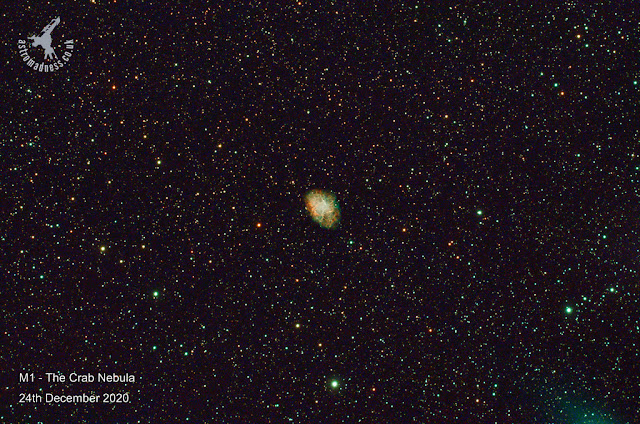M1 - The Crab Nebula
M1 - The Crab Nebula
In what might turn out to be the last post of 2020, I thought I would round off the year with an effort on M1, The Crab Nebula. The Crab Nebula is a supernova remnant found in the constellation of Taurus. It's quite small compared to many other imaging targets, but it's also visible with a decent pair of binoculars or telescope. The challenge with imaging this particular nebula is to try and tease out the detail within the nebula. Undoubtedly, a longer focal length telescope will help with this but I need to make do with my 80 ED-R.
I've also made some changes to my imaging set up to try and get the best out of it. Since I bought the Hypercam 183c, I have just been using it connected to the telescope sometimes with the reducer, and sometimes without. To get the best out of the camera and telescope combination, I needed to introduce some spacers between the camera sensor, and the telescope. In theory, this should deal with the 'stretched stars' around the edges of the full frame, in particular the corners. The correct spacing needs to be very accurate though. So, I have introduced a 15mm spacer, a variable spacer and a filter drawer into the imaging train. Bearing in mind, this is the first image with the new spacers in place, I quite pleased with the result, although I think I still need to make some small tweaks with the variable spacer. That's for another time though.
Finally, before I move onto the image itself, I have also made an experimental change with my pre-processing workflow in PixInsight. When I first started using the software, I initially used the Batch Pre Processing script to help pre process all my raw light, flat and dark files. As I got to know and use PI more, I moved onto manually performing the calibration steps to try and achieve better results. Recently though, I once again have started to struggle with dark from subtraction from my light frames meaning that I am still getting the sensor interference appearing on the right side of the final image. Since I put my workflow together, numerous enhancements and updates have been released for PI and I now think that there are some additional settings which I need to find out about to help removing this phenomena fully again. One of the improvements which has been introduced is a new script called WBPP, or Weighted Batch Pre Processing. Very similar to the original BPP script, it's had some improvements of it's own, so I thought I would give it a go. I'm really pleased with the result. The resulting image it produces once again has no sign of the sensor interference.
So, onto the images themselves. I've produced 2 images of M1. The first has been processed in PI using PixelMath to help develop the colours of the supernova remnant a little further. The second image is a cropped version with the background stars removed using he StarNet tool in PI. Both images were then lightly processed in GIMP.
Finally, thanks to anyone who has given their time to read through my ramblings over the last 12 months. Feel free to subscribe to my blog if you wish. You'll get an email anytime I post something. Have a great and more importantly, safe new year and I will be back in 2021 with more astro related drivel :-)




Comments
Post a Comment